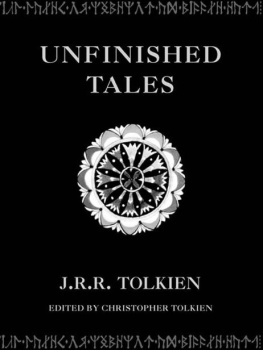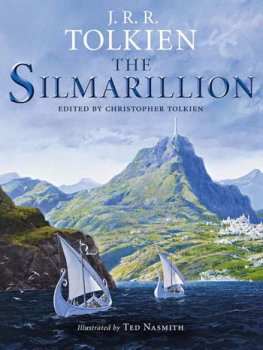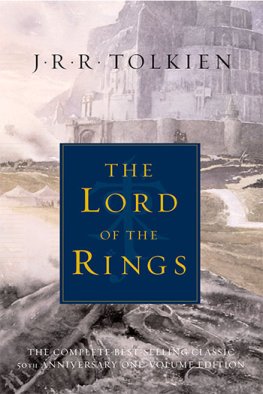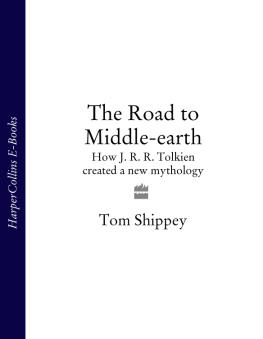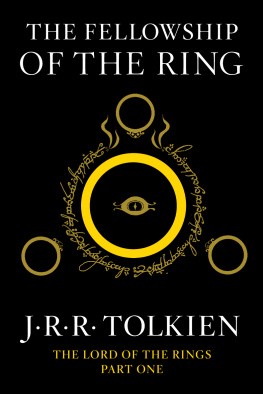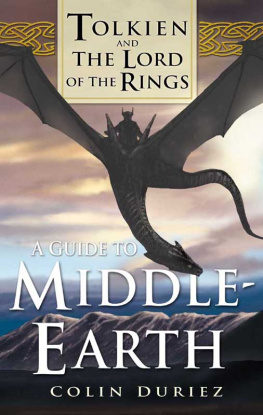

UNFINISHED TALES
of Nmenor and Middle-earth
BY
J.R.R. TOLKIEN
Edited by
Christopher Tolkien


Unfinished Tales of Nmenor and Middle-earth is a collection of narratives ranging in time from the Elder Days of Middle-earth to the end of the War of the Ring, and comprising such various elements as Gandalfs lively account of how it was that he came to send the Dwarves to the celebrated party at Bag-End, the emergence of the sea-god Ulmo before the eyes of Tuor on the coast of Beleriand, and an exact description of the military organisation of the Riders of Rohan. The book contains the only story that survived from the long ages of Nmenor before its downfall, and all that is known of such matters as the Five Wizards, the Palantri, or the legend of Amroth.
Writing of the Appendices to The Lord of the Rings J. R. R. Tolkien said in 1955: Those who enjoy the book as a heroic romance only, and find unexplained vistas part of the literary effect, will neglect the Appendices, very properly. Unfinished Tales is avowedly for those who, on the contrary, have not yet sufficiently explored Middle-earth, its languages, its legends, its politics, and its kings.
Christopher Tolkien has edited and introduces this collection. He has also redrawn the map for The Lord of the Rings to a larger scale and reproduced the only map of Nmenor that J. R. R. Tolkien ever made.
Contents
It has been necessary to distinguish author and editor in different ways in different parts of this book, since the incidence of commentary is very various. The author appears in larger type in the primary texts throughout; if the editor intrudes into one of these texts he is in smaller type indented from the margin (e.g. p. ).
Notes to texts in the Appendices are given as footnotes rather than as numbered references; and the authors own annotation of a text at a particular point is indicated throughout by the words [Authors note].
The problems that confront one given responsibility for the writings of a dead author are hard to resolve. Some persons in this position may elect to make no material whatsoever available for publication, save perhaps for work that was in a virtually finished state at the time of the authors death. In the case of the unpublished writings of J. R. R. Tolkien this might seem at first sight the proper course; since he himself, peculiarly critical and exacting of his own work, would not have dreamt of allowing even the more completed narratives in this book to appear without much further refinement.
On the other hand, the nature and scope of his invention seems to me to place even his abandoned stories in a peculiar position. That The Silmarillion should remain unknown was for me out of the question, despite its disordered state, and despite my fathers known if very largely unfulfilled intentions for its transformation; and in that case I presumed, after long hesitation, to present the work not in the form of an historical study, a complex of divergent texts interlinked by commentary, but as a completed and cohesive entity. The narratives in this book are indeed on an altogether different footing: taken together they constitute no whole, and the book is no more than a collection of writings, disparate in form, intent, finish, and date of composition (and in my own treatment of them), concerned with Nmenor and Middle-earth. But the argument for their publication is not different in its nature, though it is of lesser force, from that which I held to justify the publication of The Silmarillion. Those who would not have forgone the images of Melkor with Ungoliant looking down from the summit of Hyarmentir upon the fields and pastures of Yavanna, gold beneath the tall wheat of the gods; of the shadows of Fingolfins host cast by the first moonrise in the West; of Beren lurking in wolfs shape beneath the throne of Morgoth; or of the light of the Silmaril suddenly revealed in the darkness of the Forest of Neldoreth they will find, I believe, that imperfections of form in these tales are much outweighed by the voice (heard now for the last time) of Gandalf, teasing the lordly Saruman at the meeting of the White Council in the year 2851, or describing in Minas Tirith after the end of the War of the Ring how it was that he came to send the Dwarves to the celebrated party at Bag-End; by the arising of Ulmo Lord of Waters out of the sea at Vinyamar; by Mablung of Doriath hiding like a vole beneath the ruins of the bridge at Nargothrond; or by the death of Isildur as he floundered up out of the mud of Anduin.
Many of the pieces in this collection are elaborations of matters told more briefly, or at least referred to, elsewhere; and it must be said at once that much in the book will be found unrewarding by readers of The Lord of the Rings who, holding that the historical structure of Middle-earth is a means and not an end, the mode of the narrative and not its purpose, feel small desire of further exploration for its own sake, do not wish to know how the Riders of the Mark of Rohan were organised, and would leave the Wild Men of the Dradan Forest firmly where they found them. My father would certainly not have thought them wrong. He said in a letter written in March 1955, before the publication of the third volume of The Lord of the Rings:
I now wish that no appendices had been promised! For I think their appearance in truncated and compressed form will satisfy nobody: certainly not me; clearly from the (appalling mass of ) letters I receive not those people who like that kind of thing astonishingly many; while those who enjoy the book as an heroic romance only, and find unexplained vistas part of the literary effect, will neglect the appendices, very properly.
I am not now at all sure that the tendency to treat the whole thing as a kind of vast game is really good certainly not for me, who find that kind of thing only too fatally attractive. It is, I suppose, a tribute to the curious effect that story has, when based on very elaborate and detailed workings of geography, chronology, and language, that so many should clamour for sheer information, or lore.
In a letter of the following year he wrote:
... while many like you demand maps, others wish for geological indications rather than places; many want Elvish grammars, phonologies, and specimens; some want metrics and prosodies.... Musicians want tunes, and musical notation; archaeologists want ceramics and metallurgy; botanists want a more accurate description of the mallorn, of elanor, niphredil, alfirin, mallos, and symbelmyn; historians want more details about the social and political structure of Gondor; general enquirers want information about the Wainriders, the Harad, Dwarvish origins, the Dead Men, the Beornings, and the missing two wizards (out of five).
But whatever view may be taken of this question, for some, as for myself, there is a value greater than the mere uncovering of curious detail in learning that Vantur the Nmenrean brought his ship Entuless, the Return, into the Grey Havens on the spring winds of the six hundredth year of the Second Age, that the tomb of Elendil the Tall was set by Isildur his son on the summit of the beacon-hill Halifirien, that the Black Rider whom the Hobbits saw in the foggy darkness on the far side of Bucklebury Ferry was Khaml, chief of the Ringwraiths of Dol Guldur or even that the childlessness of Tarannon twelfth King of Gondor (a fact recorded in an Appendix to
Next page
